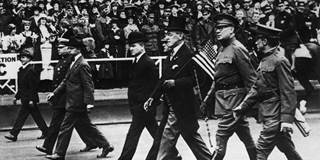In April 1917, Woodrow Wilson cast off the political yoke of neutrality and took the United States into World War I. But this is no ordinary centenary: the realization of Wilson’s vision of a US-led international order is
raising many of the same questions today that it raised then.
MEDFORD, MASSACHUSETTS – The questions surrounding events between April 1917 and April 1919 – from America’s entry into World War I until the proclamation of the Covenant of the League of Nations – are much the same questions we face today, as we begin to mark those events’ centenaries. They are questions concerning the relevance of liberal internationalism for the future, and they become more poignant with each passing day of Donald Trump’s presidency in the United States.
Fascism died with World War II in 1945 (though in many places it survives in mutated forms), just as communism died as a living ideology with the fall of the Berlin Wall in 1989. So will we now witness at the hands of the Trump administration the end of a framework that outlasted both of the twentieth century’s main totalitarian systems and brought relative order to a violent and chaotic world? If so, it is likely to be the result of issues much like those that shaped the rise of liberal internationalism a century ago.
The Roots of Neutrality
With the outbreak of war in Europe in the summer of 1914, President Woodrow Wilson faced the greatest challenge of his presidency: how might the US secure an enduring world peace once the military struggle ended? Wilson’s initial reaction to the war was to proclaim US neutrality; the country’s role would be to mediate among the warring parties. Indeed, it took more than two and a half years for the US to engage directly in the combat.

MEDFORD, MASSACHUSETTS – The questions surrounding events between April 1917 and April 1919 – from America’s entry into World War I until the proclamation of the Covenant of the League of Nations – are much the same questions we face today, as we begin to mark those events’ centenaries. They are questions concerning the relevance of liberal internationalism for the future, and they become more poignant with each passing day of Donald Trump’s presidency in the United States.
Fascism died with World War II in 1945 (though in many places it survives in mutated forms), just as communism died as a living ideology with the fall of the Berlin Wall in 1989. So will we now witness at the hands of the Trump administration the end of a framework that outlasted both of the twentieth century’s main totalitarian systems and brought relative order to a violent and chaotic world? If so, it is likely to be the result of issues much like those that shaped the rise of liberal internationalism a century ago.
The Roots of Neutrality
With the outbreak of war in Europe in the summer of 1914, President Woodrow Wilson faced the greatest challenge of his presidency: how might the US secure an enduring world peace once the military struggle ended? Wilson’s initial reaction to the war was to proclaim US neutrality; the country’s role would be to mediate among the warring parties. Indeed, it took more than two and a half years for the US to engage directly in the combat.